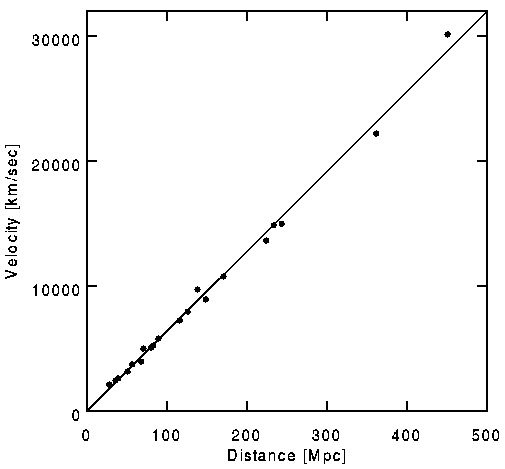Using the following graph, how would you determine approximately how fast a galaxy would be moving and if it is moving towards us or away from us in km/s if it were 1,000 Mpc from the Milky Way?

From the graph, I approximate Hubble constant as 31500/500 = 63 km/s/Mpc, nearly.. Answer: 63000 km/s.
Using the Hubble rate expressed in km/s/Mpc, I was able to approximate the slope of the correlation line as (opposite side ) / (base ) = 31500/500 = 63. This means that, at a distance of 1000 Mpc, the velocity is approximately 63000 km/s.
By signing up, you agree to our Terms of Service and Privacy Policy
A galaxy's velocity and direction of motion can be ascertained by following these steps: 1. Locate the galaxy's redshift on the graph; 2. Use the redshift to calculate the velocity using the Hubble's Law equation: v = H0 × d, where d is the distance to the galaxy; 3. Plug the distance of 1,000 Mpc and the value of the Hubble constant into the equation to find the velocity; 4. If the velocity is positive, the galaxy is moving away from us; if the velocity is negative, it is moving towards us.
By signing up, you agree to our Terms of Service and Privacy Policy
When evaluating a one-sided limit, you need to be careful when a quantity is approaching zero since its sign is different depending on which way it is approaching zero from. Let us look at some examples.
When evaluating a one-sided limit, you need to be careful when a quantity is approaching zero since its sign is different depending on which way it is approaching zero from. Let us look at some examples.
When evaluating a one-sided limit, you need to be careful when a quantity is approaching zero since its sign is different depending on which way it is approaching zero from. Let us look at some examples.
When evaluating a one-sided limit, you need to be careful when a quantity is approaching zero since its sign is different depending on which way it is approaching zero from. Let us look at some examples.

- 98% accuracy study help
- Covers math, physics, chemistry, biology, and more
- Step-by-step, in-depth guides
- Readily available 24/7
 John Alexander
John Alexander Hazel Asher
Hazel Asher